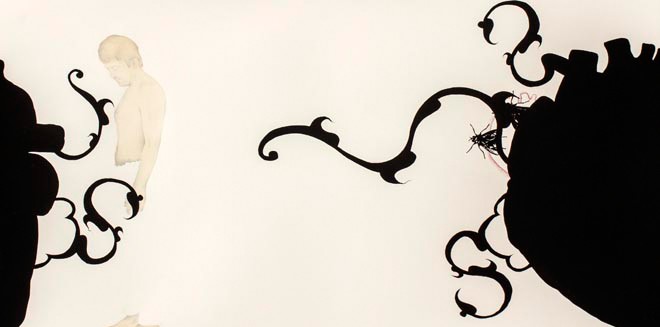

The literal meaning of Islam is peace but one yearns for peace in a society that is exposed to all sorts of threats from the holy warriors of Islam. Often, people with liberal education, attractive jobs and charming personalities are seen confront those who are different from them in belief, race, ethnicity or geographic location.
This brings to mind the twin notions -- of Islam being a militant religion spread through swords of conquerors across continents, and Islam spread through sages, Sufis and preachers who convinced huge populations to a new belief that recognised all human beings as equal.
Thus, in recent years, apart from individuals who abandon their families to go to alien lands to preach, there are a number of enthusiasts who are prepared to fight the non-believers to establish the kingdom of God.
Interestingly, Imran Mudassar has experienced this phenomenon of preaching firsthand. A graduate of National College of Arts with a Fine Arts Major, and an MFA from the College of Art and Design at The University of Punjab, Imran has already carved a name for himself among the new generation of artists. Although he studied printmaking, his interest and inclination for the miniature vocabulary was evident from his Degree Show in 2002. Since that time he has been involved in exploring the link of sacred with the scared -- an appropriate theme because in today’s age a bearded man or burka-clad woman arouse far more fear than piety.
Attraction toward religion led him to join the preachers’ group for a short while when Mudassar sincerely hoped to guide people in the teachings of faith. Soon he became disillusioned. He felt that in the guise of selfless service to religion, his colleagues were seeking personal glory and had a condescending opinion about the to-be-preached. This realisation about the seemingly pious and sincere led him to return to his ‘normal’ life.
However, that brief association added a new element to his art. In his previous works, Mudassar has been combining visuals of holy content with images of violence. Thus the covers of sacred manuscripts were composed with outlines or silhouettes of hand grenades etc. It was a comment upon the militant side of the believers. In the recent body of works, too, Imran seems to be conveying the same content but the choice of symbols and idioms is more selective and sophisticated.
In these works, mostly inks on paper, a man is confronted with all sorts of dangers. The artist has picked up a clear and sophisticated set of imagery to denote his idea, position and experience (especially after his sojourn of the Tableeghi jamaat!). In the body of works (from his current exhibition ‘Love or Hate’, being held from May 7-24, 2014 at Rohtas 2, Lahore) Imran Mudassar seems to be dealing with the same issue -- an extremist version/representation of Islam that has been disturbing our security forces, media, government and the world at large.
These larger concerns turn into an intimate and personal narrative, where a man’s body or self is confronted by invaders of all kinds -- ranging from attacks by outside powers to inquisitions from forces of orthodoxies. The elements from exterior come in the shape of aeroplanes, drones, grenades and canons. Or he faces the unbearable situation of dealing with his self or his replica (or the Other). In some works, man is reproduced in his identical half, and is joined or intersected with him.
This formal device -- of rendering two sides of one figure -- can be read as a symbolic representation of a much divided society, in which one part is up against the other section, regardless of both sharing countless common characteristics.
Arguably, the present day Pakistani society is the most segregated group of a people, when it comes to matters of politics and political Islam; or the problem of how to tackle extremism. This confusion is created because the majority of our population fails to differentiate between Islam as the peaceful religion and a faith that should be imposed by the force.
This debate of religion and its power is obliquely addressed in many of Mudassar’s works, in which arabesque (traditionally seen inside or on the cover of sacred texts) are composed with tools of destruction. Floral pattern emerges from the shape of a hand grenade, or next to the outlines of fighter planes.
All this imagery signifies the condition of our times and place which, like Imran Mudassar’s imagery, content and technique, has not changed much over the period of several years. It also brings forth a query or dilemma: the subject or situation remaining the same, does an artist uses the same visual language.
It seems that Imran Mudassar has been following the course of a faithful commentator, but if the political situation has not changed much, the artist may modify his ideas, imagery and pictorial devices in order to remain relevant and interesting.